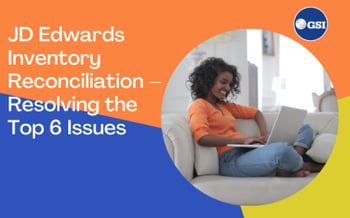How to Resolve the Top 6 Issues with JD Edwards Inventory Reconciliation
 JD Edwards Inventory Reconciliation – Resolving the Top 6 Issues
JD Edwards Inventory Reconciliation – Resolving the Top 6 Issues
Edwards Gutkowski - Chief Architect RapidReconciler
Welcome to this series of articles on resolving the top 6 issues associated with reconciling JD Edwards inventory. In my 20+ years as a distribution consultant, I have compiled a list of the most frequent causes of reconciling items. Here are the top 6 issues:
- Automatic accounting instructions
- GL class code control
- Product costing
- Process controls over end of day transactions
- Cardex variances
- Inventory reporting methodology
Each month I will cover one topic with explanations and resolutions. This month let’s tackle DMAAI’s, more affectionately known as Distribution/Manufacturing Automatic Accounting Instructions. You can access these in JDE using fast path command DMAAI, as long as you have the security to do so. Below is a sample of the DMAAI UI.
DMAAI’s are the mapping for every inventory transaction to the general ledger and are vitally important to the reconciliation process. Each inventory transaction performed results in a debit and credit to the GL account specified in the tables. These tables represent over 70% of the root causes of all inventory reconciling items!
What can go wrong?
There are 2 main factors to consider when setting up DMAAI’s:
- Limit the use of wildcards – A ‘wildcard’ of ‘00000’ or ‘****’ can be used in the company number or GL class fields respectively. This basically means any company or GL class used in the transaction would match the entry and post. At times this can lead to unintended entries in the ledger, causing a reconciliation issue.
- Bad account information – The Branch Plant, Object or Sub data is entered incorrectly. I don’t think I need to clarify the entry would be bad if the account information is incorrect!
How can you mitigate this issue?
You can mitigate this issue by using the concept of a ‘Model DMAAI Table’, which is illustrated in the picture below. What this means is picking one of the DMAAI tables, such as the 4152, and vetting it to make sure it is perfect. Then that set up can be compared to all the other balance sheet DMAAI’s listed and differences resolved.
As a side note … the RapidReconciler product from GSI has built in integrity reports that perform this function. Please contact us for more details. Next month … GL class code control. Stay tuned!
